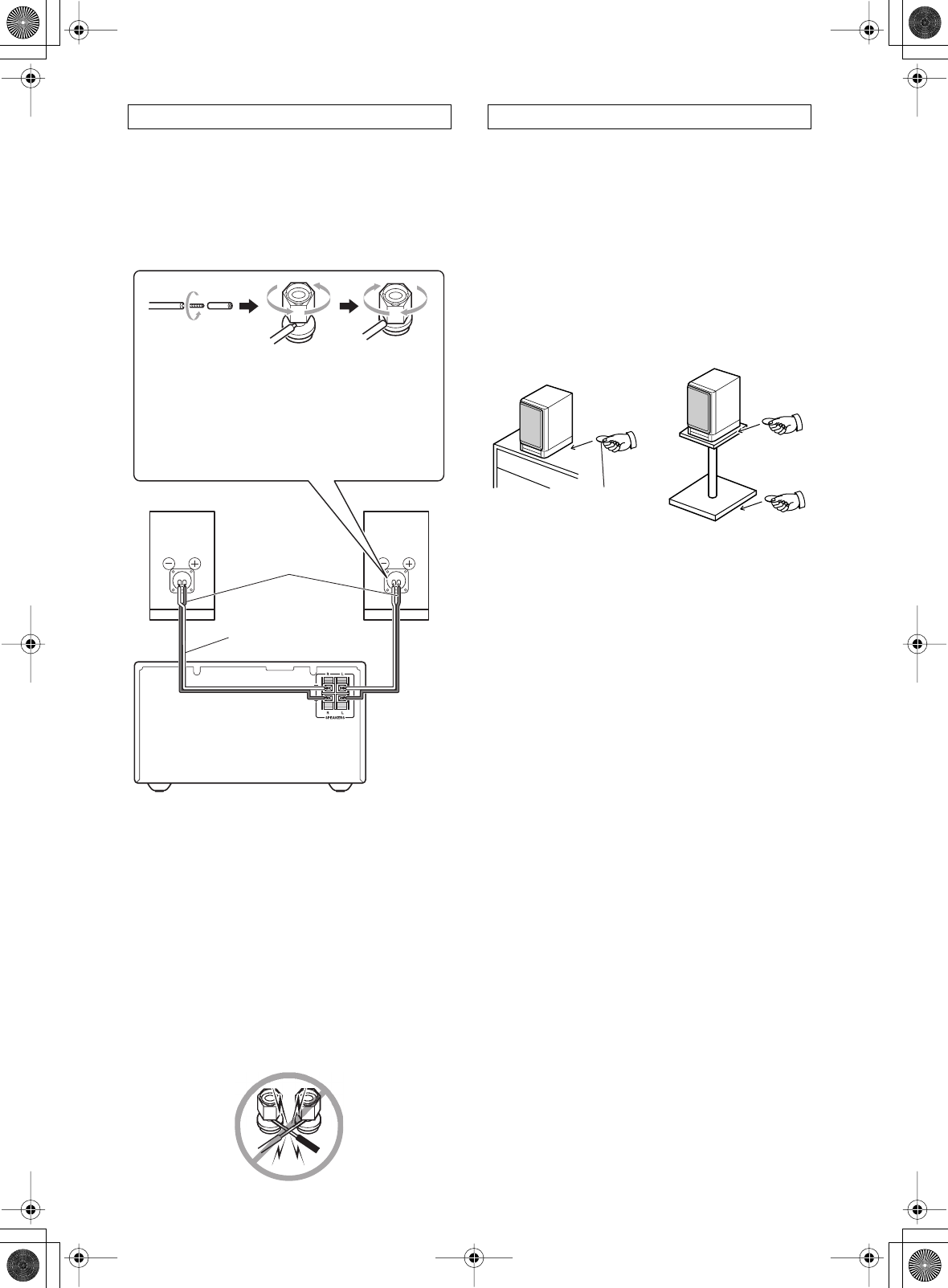
3
• Before connecting the speakers, disconnect your
amplifier’s power cord from the wall outlet and set its
volume control to minimum.
• The speaker’s rated impedance is 4
Ω
. Make sure you con-
nect an amplifier that is compatible with a 4
Ω
impedance.
• Use the supplied speaker cables to connect the speak-
ers to your amplifier as shown.
The type of speaker terminals used on the receiver and
their position depends on the model. Refer to the
receiver’s instruction manual for details on connecting
speakers to the receiver.
Before Turning on Your Receiver:
• Make sure the speaker’s positive (+) terminals are
connected to the amplifier’s positive (+) terminals,
and the speaker’s negative (–) terminals are con-
nected to the amplifier’s negative (–) terminals. If you
get the polarity reversed, the sound will be unnatural,
with a limited bass range and poor stereo image.
• Make sure that the positive (+) and negative (–) wires
are not touching each other. If they are, a short circuit
may occur, damaging your amplifier.
The sound quality of the speakers is directly affected by
the size and shape of the room they’re used in and its
furnishings. When considering where to place your
speakers, read the following:
• Where possible, mount the speakers on speaker
stands, concrete blocks, bricks, or a sturdy bookshelf.
Putting them directly on the floor will emphasize bass
sounds, creating a boomy sound.
• If a speaker is placed on an uneven surface where it
can wobble or vibrate, bass performance will be
adversely affected. You can eliminate speaker wobble
by putting a shim made out of cork or metal, such as a
coin, underneath the speaker or stand, as shown.
• If you mount the speakers on a flat surface, such as a
bookshelf, you can improve the sound quality by
inserting cork spacers or coins in between the speaker
and the shelf. Raising them off the surface like this
will reduce the contact area and improve the sound.
• If you like lots of bass, mount the speakers on low
speaker stands and place them in front of a solid wall.
•Walls and furnishings affect sound quality. To achieve
a good stereo sound, put the left and right speakers in
similar locations at the same distance away from your
listening position and at the same height. If you put
them in totally different locations, for example, one
on the floor and the other on a bookshelf, the stereo
imaging will be adversely affected.
•To determine the best positions for your speakers,
imagine an equilateral triangle and put the left and
right speakers at the ends of the base. The ideal listen-
ing position is at or slightly behind the triangle’s
apex. Angle the speakers toward your listening posi-
tion.
• Glass doors and smooth walls behind the listening
position can reflect the sound from the speakers and
can make sounds at certain frequencies louder. You
can prevent this by hanging sound-absorbing mate-
rial, such as thick curtain, on the door or wall.
D-N10BX
• Please note that the speakers’ surface features a spe-
cial finish. An object placed on the speakers for a
long period of time may leave a trace or mark. Adhe-
sive tape may also leave a mark.
Connecting the Speakers
Right speaker Left speaker
Speaker cable
Positive (+) side is
indicated by a
red line
D-N10BX
shown
1.Peel the
insulation off
the ends of
the speaker
cable and
twist the
core wires.
2.Loosen the
terminal screw
and insert the
speaker cable
into the hole
(until the core
wires are
inserted fully).
3.Fasten the
terminal
screw.
Speaker Placement
Shim
D-N10BX,N9BX,N7BX_En.fm Page 3 Thursday, May 25, 2006 5:42 PM






